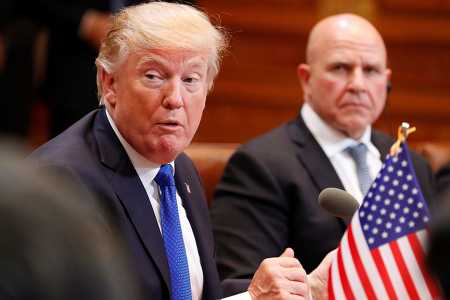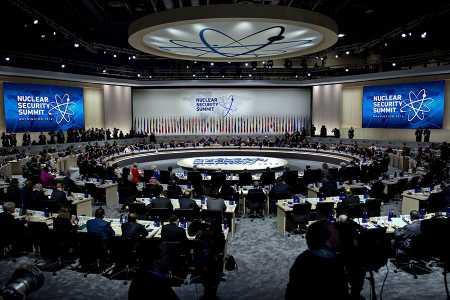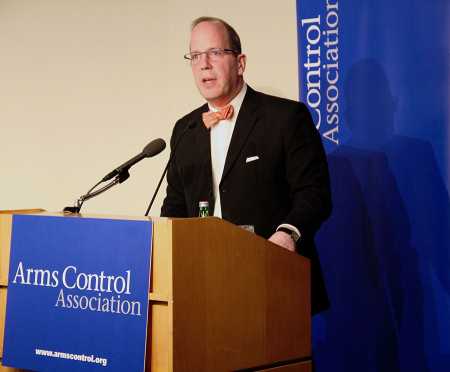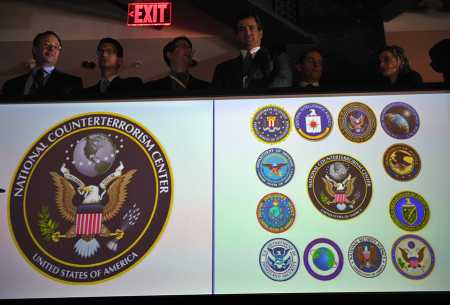“For half a century, ACA has been providing the world … with advocacy, analysis, and awareness on some of the most critical topics of international peace and security, including on how to achieve our common, shared goal of a world free of nuclear weapons.”
The Enduring Challenge of Nuclear Security Coordination
January/February 2018
By Laura S.H. Holgate
Nuclear weapons in the hands of terrorists can kill millions and wreak the world. This essential truth underpins the enduring, bipartisan U.S. commitment to enhancing the security of nuclear weapons and the materials that can make them.
 This task has become more multifaceted over time, and the bureaucratic machinery by which the United States pursues these goals has grown in size and complexity. Aligning the legal authorities, available funding, and institutional capacity of more than a dozen departments and agencies involved in policymaking and programmatic implementation for nuclear security is an enduring challenge—one made more difficult in the absence of senior political appointees.
This task has become more multifaceted over time, and the bureaucratic machinery by which the United States pursues these goals has grown in size and complexity. Aligning the legal authorities, available funding, and institutional capacity of more than a dozen departments and agencies involved in policymaking and programmatic implementation for nuclear security is an enduring challenge—one made more difficult in the absence of senior political appointees.
U.S. nuclear security policies are pursued through a variety of avenues, including public and private statements by senior officials in bilateral and multilateral settings; scientific research on threats and the technologies to thwart them; training and capacity building with partners at home and overseas; negotiation of treaties and other international instruments; design and enforcement of national laws and regulations; provision, installation, and maintenance of equipment domestically and abroad; intelligence gathering and analysis; partnerships with related industries and civil society groups; and formal and informal international counterpart relationships at all levels and across all agencies.
Coordination of these myriad actors on a global stage is critical to achieving intended outcomes and to effective use of taxpayer resources. Absent deliberate and accountable coordination at all levels, messages get muddled, money gets wasted, equipment goes unused, gaps go unnoticed, opportunities are missed, and good will is squandered. No one wins awards or makes headlines with this thankless task. Yet without it, U.S. security is at greater risk; and aspiring nuclear terrorists are more likely to acquire the materials, skills, and opportunities to kill millions and inflict economic and political havoc on a global scale.
Effective coordination starts at the White House and engages more than a dozen departments, agencies, and offices. Even the best leadership will struggle with enduring coordination challenges, such as internally aligning programs and policies, working with Congress, liaising effectively with international partners, and facilitating information flow. President Donald Trump’s delays in filling key positions dealing with these matters makes coordination more difficult and reduces U.S. influence in addressing these vital issues internationally.
The National Security Council
The National Security Council (NSC) is at the apex of interagency coordination and closest to the president but often less visible to those outside the interagency process. Within the NSC, the lead player in nuclear security coordination is the directorate designated to deal with weapons of mass destruction (WMD), typically led by a senior director, but which changes its name, structure, and size with each administration.
 Other NSC offices are also involved; a dedicated staff member in each of the regional directorates often handles significant nuclear issues, such as East Asia, South Asia, and Russia. Depending on the issue, other NSC offices are also relevant, particularly those dealing with counterterrorism, multilateral affairs, and intelligence. NSC offices responsible for legislative and public affairs frequently are key partners.
Other NSC offices are also involved; a dedicated staff member in each of the regional directorates often handles significant nuclear issues, such as East Asia, South Asia, and Russia. Depending on the issue, other NSC offices are also relevant, particularly those dealing with counterterrorism, multilateral affairs, and intelligence. NSC offices responsible for legislative and public affairs frequently are key partners.
As with the rest of the U.S. government, there is a built-in tension between regional and functional offices. In noncrisis times, this usually manifests itself in disputes over the agenda and talking points for meetings of the president or the national security adviser with his or her counterparts. The regional offices control the preparatory efforts for such engagements and have the last chop on the paper flow, and the regional senior directors are usually the last NSC staff person to brief the president before conversations with other heads of state.
This puts a premium on building strong day-to-day relationships between the WMD office and the regional offices so that key nuclear security issues are not being hashed out at the last minute as papers are due to the Oval Office, but rather that the regional teams understand the nuclear security landscape with key countries and work routinely with the nuclear team to frame and prioritize issues. In this sense, intra-NSC coordination is as critical as interagency coordination and depends heavily on the culture and expectations set by the national security adviser.
Alongside the NSC, the Office of Science and Technology Policy provides critical technical input and shares some of the coordination and writing burden. Its involvement can also be an important signal of credibility to the scientific community that its concerns are visible during the policy process.
Sometimes, the National Economic Council (NEC) is a relevant participant, especially where nuclear energy and nuclear security intersect, such as "123 agreements” for peaceful nuclear cooperation and spent nuclear fuel storage. The international economics team is typically dual-hatted between the NSC and NEC, and it runs the interagency processes related to the Group of Seven and the Group of 20, where nuclear security topics are often addressed.
The Office of Management and Budget (OMB) plays a key role in coordination between policy and resources. The OMB’s visibility on the ebb and flow of policy enhances its own carefully choreographed annual budget process. Ideally, the OMB national security team is on good, transparent terms with the NSC nuclear team and will seek views from the policy side as it is considering agency budget submissions. Yet, that does not always happen, and it takes effort and intention to make it work.
The NSC’s role is fundamentally coordination of the myriad U.S. government actors involved in developing and implementing nuclear security policy. A presidential directive, usually the first one issued by a new administration, establishes this process. Most coordination happens through interagency meetings at rising levels of seniority, from sub-interagency working groups led by NSC staff to interagency working groups led by NSC senior directors to deputies committees led by a deputy national security adviser to principals (cabinet officials) committees chaired by the national security adviser to formal NSC meetings of cabinet officials chaired by the president.
 These meetings are used to prepare for events such as presidential meetings or multilateral gatherings; to develop response options for crises or ongoing issues, such as North Korea or Russia; to formally approve major policy documents, such as presidential directives; to obtain buy-in from senior officials who will need to be personally involved in policy implementation; and to resolve any other major interagency disagreements. Most nuclear security issues are determined at the working group levels because office directors, deputy assistant secretaries, and assistant secretary-level officials usually are adequately empowered to make the necessary programmatic, budget, and policy decisions regarding nuclear security issues and because the deputies and principals committees’ schedules are so constrained and the calendars of the deputies and cabinet secretaries are so packed that they rarely have time for nuclear security issues. Senior directors are generally expected to solve as many problems as possible at their level or below, but also to crystallize open issues and help agencies prepare their deputies or cabinet secretaries for participation in deputies and principals committees.
These meetings are used to prepare for events such as presidential meetings or multilateral gatherings; to develop response options for crises or ongoing issues, such as North Korea or Russia; to formally approve major policy documents, such as presidential directives; to obtain buy-in from senior officials who will need to be personally involved in policy implementation; and to resolve any other major interagency disagreements. Most nuclear security issues are determined at the working group levels because office directors, deputy assistant secretaries, and assistant secretary-level officials usually are adequately empowered to make the necessary programmatic, budget, and policy decisions regarding nuclear security issues and because the deputies and principals committees’ schedules are so constrained and the calendars of the deputies and cabinet secretaries are so packed that they rarely have time for nuclear security issues. Senior directors are generally expected to solve as many problems as possible at their level or below, but also to crystallize open issues and help agencies prepare their deputies or cabinet secretaries for participation in deputies and principals committees.
The NSC also coordinates interagency activity through paper review of press guidance, briefing memos and talking points for senior officials, instructions for delegations and embassies, and congressional testimony. Jointly with the OMB, the NSC leads discussions on agency budgets, although the sanctity of the OMB’s unique authority over agencies on budgetary decisions is important to preserve.
Departments and Agencies
The primary Department of State office for nuclear security issues is the Bureau of International Security and Nonproliferation, led by an assistant secretary. The bureau is home to a large number of career civil servants who become deep subject matter experts, working alongside Foreign Service officers assigned on a temporary basis. The bureau oversees a modest budget for a range of nuclear security activities, primarily in training, and has the interagency lead on treaties related to nuclear security. It also leads interagency coordination of routine bilateral and multilateral nonproliferation dialogues held by the assistant secretary or undersecretary.
Most nuclear security issues also involve one or more regional bureaus, and issues involving the International Atomic Energy Agency (IAEA) and the United Nations involve the Bureau of International Organization Affairs. Embassies worldwide are responsible for facilitating delegations and providing ongoing connectivity and diplomacy with relevant international counterparts.
The Department of Defense has multiple offices and communities, and it has an enormous internal coordination burden. The Office of the Undersecretary of Defense for Policy nominally has the lead for interagency engagement, including representation at NSC meetings, where responsibility for nuclear security falls to the assistant secretary for global affairs and homeland security. In some instances, other parts of the department, such as the acquisition team, where policy is turned into contracts, or the Defense Threat Reduction Agency, which has programmatic responsibility for most Defense Department nuclear security efforts, work directly with interagency counterparts. The Joint Staff is also typically represented at interagency meetings. This gives the Defense Department two “votes” at the interagency table, although the Joint Staff position is statutorily subordinate to the Office of the Secretary of Defense.
Responsibility for synchronizing Defense Department's countering-WMD missions shifted from U.S. Strategic Command (StratCom) to U.S. Special Operations Command (SOCOM) in October 2016. This adjustment reflected the growing recognition of the nonstate actor WMD threat after Islamic State forces formulated and used their own mustard agent in attacks in Iraq and Syria. SOCOM’s expertise in counterterrorism offers more applicable tools and an activist posture compared to the primary deterrence role of StratCom.
SOCOM appears to be taking a much more active role in the nuclear security mission, but it lacks familiarity with the nuclear interagency process. How engaged SOCOM and its policy counterpart, the assistant secretary for special operations and low-intensity conflict, will be in the interagency process remains to be seen. Unchanged, however, is the specialized role of SOCOM assets in responding to any suspected nuclear terrorism device or event overseas.
The Department of Justice and the FBI are less well-known participants on nuclear security issues. They lead the U.S. government response to any potential terrorist-related nuclear activity on U.S. territory. This uniquely sensitive role requires working painstakingly through the procedures for delegating presidential nuclear authorities down to specially trained FBI or military teams operating directly on a suspect device and on the interagency network that is generated to support a domestic or overseas incident. The FBI’s WMD Directorate plays a key role in liaising with law enforcement officials around the world and through Interpol, and it provides critical nuclear forensics capacity for use in domestic criminal investigations.
 The Department of Energy, through the semiautonomous National Nuclear Security Administration (NNSA), currently makes the largest budgetary and programmatic contributions to U.S. nuclear security activities under the Office of Defense Nuclear Nonproliferation, led by an assistant secretary-level appointee. This office combines policymaking and programmatic responsibilities. Many of the programs and activities of the NNSA, as well as other agencies, are executed by Energy Department national laboratories. These labs provide research and development, technical expertise, program management, and, in many cases, personal connections to counterparts overseas that ease doors open to nuclear cooperation.
The Department of Energy, through the semiautonomous National Nuclear Security Administration (NNSA), currently makes the largest budgetary and programmatic contributions to U.S. nuclear security activities under the Office of Defense Nuclear Nonproliferation, led by an assistant secretary-level appointee. This office combines policymaking and programmatic responsibilities. Many of the programs and activities of the NNSA, as well as other agencies, are executed by Energy Department national laboratories. These labs provide research and development, technical expertise, program management, and, in many cases, personal connections to counterparts overseas that ease doors open to nuclear cooperation.
In addition to the nonproliferation office, the NNSA Counterterrorism and Emergency Response offices play critical roles in preparations for searching and handling nuclear and radiological materials and in working with other countries to increase their radiological and nuclear response capacity, as well as to provide reach-back technical advice to those countries in real-time, real-life incidents. The Energy Department is responsible for the management of the 17 national laboratories and multiple industrial facilities involved in nuclear weapons production, nuclear energy research, and environmental cleanup, and the department establishes and oversees the nuclear security regulations for those sites.
The Department of Homeland Security’s main contribution to nuclear security comes through the Domestic Nuclear Detection Office (DNDO), responsible for research, acquisition, and deployment of radiation detectors around the country and among federal, state, and local officials. This office also has the interagency responsibility for centralized nuclear forensics analysis. By statute, it produces the Global Nuclear Detection Architecture, which describes the placement and capabilities for nuclear detection across the U.S. government and internationally. The interagency process by which this document is created and approved helps focus international priorities, and the DNDO has its own international relationships with customs and immigration officials overseas.
The primary interagency representation of the intelligence community on nuclear security issues comes from three parts of the Directorate of National Intelligence, which sits above the various intelligence agencies: the national intelligence officer for weapons of mass destruction, the National Counterproliferation Center, and the National Counterterrorism Center. The CIA office known as the Weapons and Counterproliferation Mission Center is also active in bringing intelligence information and analysis into the policy and program communities. Most of the other intelligence agencies also have specific nuclear security expertise and missions, and most of the cabinet agencies mentioned above have an intelligence component that contributes through the intelligence community.
Coordination within the intelligence community on nuclear security issues has always been challenging, and a recent effort to create a dedicated, all-source, cross-community team focused exclusively on nuclear terrorism was not successful. More successful has been the decade-plus project hosted by the Energy Department intelligence office to gather all information about the security of nuclear material in storage and transport globally into a single platform known as the Nuclear Materials Information Program. This set of information helps inform presidential briefings on nuclear security threats and programmatic prioritization of countries and facilities.
The U.S. Mission to the United Nations, which is organizationally and functionally separate from the State Department, is a key player for any aspect of nuclear security that takes place in New York. Activities related to UN Security Council Resolution 1540, Security Council meetings focused on nonproliferation and nuclear security, and the like are engaged in close coordination with the U.S. mission.
The independent status of the Nuclear Regulatory Commission (NRC) puts it in a special category regarding coordination. On one hand, it does not take direction from the executive branch in setting the standards for domestic civilian nuclear facilities, including nuclear security regulations. On the other hand, they participate in policy discussions regarding nuclear security regulations and practices in other countries, and they have robust cooperative relationships with regulatory counterparts around the world.
The NRC plays a key role in reviews of security practices for U.S.-origin nuclear materials exported under "123 agreements” and provides significant expertise in consultations with the IAEA on nuclear security. Its independent status has created tensions based on concerns that interagency efforts to enhance international nuclear security standards or guidelines could add burdens to U.S. licensees or imply a critique of U.S. regulations.
All of these participants had roles in creating the success of the biennial nuclear security summits held from 2010 to 2016. The design and preparation of these events was driven strongly by the NSC, reflecting their origin as a personal priority of President Barack Obama, and the NSC led the small U.S. delegations to the summit planning meetings.
Determining the summits’ outcomes, however, required numerous sub-interagency and interagency working groups to refine policy goals for the summit communiqués, as well as to identify, prioritize, and extract high-impact deliverables from participating countries. Deputies and principals committees were used to gain leadership approval on the summit design and engagement in pursuing high-priority deliverables with their counterparts and to prepare cabinet officials for their own participation in the summits. Special intelligence products were developed, in coordination with interagency input, to brief Obama and other senior officials. The clear connection of priorities from action officer to the president and the empowerment that came from that connection were critical components of the summits’ impact in reducing nuclear material and preventing nuclear smuggling.
Coordination Challenges
The quality and effectiveness of coordination among these agencies varies greatly over time and among issues. Five enduring coordination challenges require attention, even if they are unlikely ever to be fully resolved.
First is the clarification and adjustment of programmatic roles and missions among the agencies in a way that aligns their legal authorities, budgets and capacities. Some of this is done around an NSC table, but often it is best done at operational levels on a topical basis among related programs. Obvious as this may be, stovepipes based on personality, information access, and turf will emerge from the best-intentioned coordination process and will always need to be broken down. Further, any informal coordination methods will reflect the peculiarities of the people and issues involved.
Second, it seems that every administration has to relearn the value of having common themes for agency witnesses to incorporate into their congressional budget testimony, given the distributed nature of nuclear security budgets and authorities across departments and across congressional oversight committees. In one example, a one-page overview of the agreed nuclear security strategy was developed for each department witness to place at the beginning of their testimonies in order to reflect how agency efforts complemented each other toward a coherent whole-of-government approach.
Third, management of the connection points with international partners is always a challenge. No country matches the depth and breadth of U.S. officials. U.S. delegations and programs are at constant risk of overwhelming the bandwidth of foreign partners. U.S. embassies often fight a losing battle in seeking to rationalize, prioritize, and sequence interagency activities. This is another good reason to build relationships in Washington between functional and regional teams so that embassy officials are hearing consistent messages from their own reporting chains and interagency delegations. Functional teams can also do a better job of finding ways to combine and prioritize contacts with overseas counterparts.
Fourth is the sharing of relevant information among all who need it to do their jobs. To best serve policymakers and program managers, clandestinely acquired information needs to be supplemented with tacit knowledge that any government official or contractor absorbs by virtue of their interactions in the course of doing their jobs. The responsibility to record and appropriately distribute this information extends from program implementers to senior officials, and it can be effectively performed without crossing sensitive lines between active collection and nonintelligence functions.
In this modern environment of diverse communications threads shifting from formal, old-fashioned cables to official emails and informal texts, opportunities can be missed to have a common picture of relevant facilities, communities, and technologies that feeds intelligence analysis, threat assessments, programmatic prioritization, and diplomatic engagement. When leaders make expectations clear and administrative barriers are low, this can work well, but it requires constant attention and development of trust over time.
The fifth point is the challenge of coordinating nuclear security policy with nuclear weapons and disarmament policy. In the United States, these are often managed by separate communities, and U.S. nuclear security and disarmament policies are not seen as interdependent, much less in conflict. For many other countries, especially non-nuclear-weapon states, this is not true, and many of them perceive the lack of progress on disarmament as more of a threat to their security than nuclear terrorism. They believe that terrorists are not sophisticated enough to build a weapon and that even if they did, it would be targeted at the United States or maybe Europe.
This perception has caused many countries and collectively the Non-Aligned Movement to perceive nuclear security cooperation as a favor they do for the United States and to hold global progress on nuclear security, such as at the IAEA, hostage in the absence of progress on disarmament. Although the process created by the new nuclear weapons prohibition treaty could provide a forum for countries to express their views on disarmament, it may only inflame the divisiveness in multilateral settings. This will require more coordination between U.S. positions and priorities on nuclear security and disarmament.
Effective coordination of policies, programs, and information flow is heavily dependent on the individuals involved. Many of the capable U.S. career officials have strong habits of working together, but the true character of coordination awaits the arrival of confirmed officials in assistant secretary-level positions, few of whom have even been nominated to lead the offices and bureaus described above.
Without confirmed officials in place, career staff can be unwilling to take risks or make decisions that could conflict with future policy direction from unknown bosses-to-be. “Acting” officials tend to have less impact in presenting and defending budgets internally and before Congress, and they often are not included in meetings with their cabinet secretary that generate guidance or decisions. In deputies and principals committees, acting officials can be less effective in debates with more senior, confirmed counterparts from other agencies. In a crisis, these leadership gaps can interfere with rapid decision-making, as well as the kind of authoritative interactions with international counterparts that would be required to build a collective response.
As long as the nuclear security interagency leadership remains thin, coordination will be incomplete, and the United States will be less capable to prevent or respond to a nuclear event. This should worry us all.
Laura S.H. Holgate is a senior fellow at the Belfer Center for Science and International Affairs at Harvard University’s Kennedy School of Government. She has been a U.S. representative to the United Nations Office at Vienna and the International Atomic Energy Agency and a special assistant to the president and senior director for weapons of mass destruction, terrorism, and threat reduction on the National Security Council.
